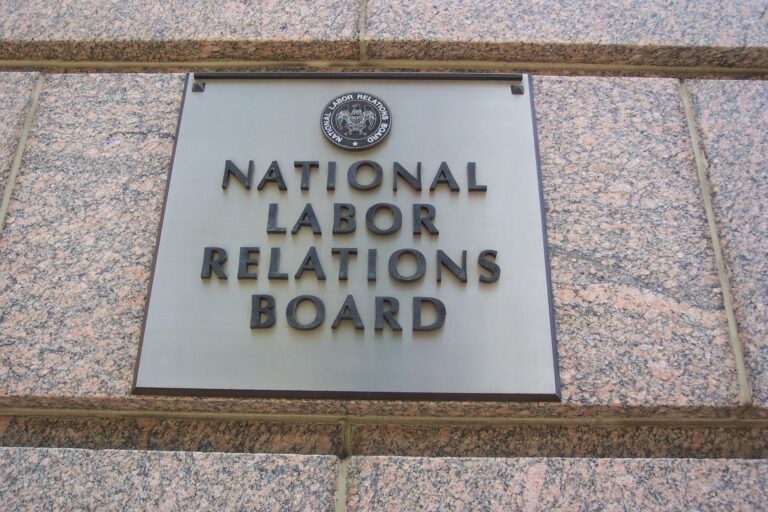
Sharon Block is a Professor of Practice and the Executive Director of the Center for Labor and a Just Economy at Harvard Law School.
Last week the Biden Administration announced that federal-employee unions gained more than 80,000 members in one year. That’s a lot of new union members. Union membership overall increased by only 270,000 last year. And I would argue that it isn’t a coincidence that this big increase happened on the watch of the president who proudly refers to himself as the most pro-union president ever.
Dissecting the reason for federal-employee unions’ success is important not only to inform the organizing strategy for unions in other sectors but also to inform the future of labor law reform. Understanding this increase is important for labor law reform because federal employees operate under a different labor law than private-sector or state public-sector workers. President Biden’s pro-federal sector union policies have made that difference even greater. So maybe if we can understand some of those differences, we can understand what changes in private-sector labor law might yield similar success.
Let’s start with the context in which federal-sector union-organizing campaigns take place. No matter who is president, the federal government cannot spend money countering union-organizing campaigns. Some people interpret that as meaning that the federal government is neutral in employee-organizing campaigns. To an extent that is true. But in practice there are degrees of neutrality. While the technical rules may have dictated that the Trump Administration remain “neutral” in federal-sector organizing campaigns, few federal employees would have had any question about how Trump felt about federal-employee unions. He took many executive actions to undermine them and strip them of much of their power. President Biden, however, started on Day One of his Administration to send the exact opposite signal. He first retracted the bad Trump Executive Orders regarding federal sector unions.
I think it is fair to say that Kiran Ahuja, Director of the Office of Personnel Management (which serves as the HR department for the federal government), moved the government back to a traditional posture of neutrality in union-organizing campaigns — away from the hostility of the Trump Administration. She issued a memo to all agencies reminding them of their responsibility to remain neutral — that is, to ensure that workers can make a free and uncoerced decision about union representation.
President Biden, however, when speaking to the public at large has moved beyond neutrality. He frequently conveys his support for labor unions, he has invited labor leaders back to the White House, including those involved in high-profile organization campaigns, and he has stated publicly that it is his administration’s policy to “support … worker power, worker organizing, and collective bargaining.” While his pronouncements and actions do not run afoul of regulations regarding neutrality in federal-sector organizing because he is speaking generally, there can be no doubt that federal employees are aware of his perspective.
Biden did much more than just not be Trump or speak in support of labor generally. His administration also put in place several polices that created conditions of true neutrality. For example, the Office of Personnel Management put out memos to ensure that federal managers maintained real neutrality during organizing campaigns. Those memos directed managers to consult with labor-management specialists before responding to employees’ questions about organizing to ensure that they did not convey any inaccurate or biased information. OPM also directed federal managers to actually make it easier for unions to organize. For the first time, agencies are required to allow unions to post information about their organization and contact information for union representatives on office bulletin boards, public websites, or employee-only intranets. OPM also directed agencies to share a list of bargaining-unit employees and their work email addresses with union officials and to invite unions to participate in the orientation process for new bargaining unit employees.
The Biden Administration also encouraged agencies to restart labor-management forums, which the Trump Administration had tried to shut down. These forums are collaborative mechanisms for the unions, workers, and agency management to discuss issues of common interest and to engage in predecisional exchanges — that is to be a place for managers to get input from unions before making decisions that do not have to bargained. They are somewhat like works councils.
In addition, the Biden Administration made it policy that federal agencies should agree to bargain with unions over permissive subjects of bargaining. That commitment opened up for bargaining topics such as numbers, types, and grades of employees or positions assigned to any organizational subdivision, work project, or tour of duty, or on the technology, methods, and means of performing work. The range of mandatory subjects of bargaining in the federal sector is narrower than the private sector. There is no bargaining over wages or benefits. Thus, adding to the mix these permissive subjects greatly expands the role of federal sector union bargaining.
Finally, the Biden Administration even took steps to ameliorate the impact of one of the ways that federal-sector labor law is less protective of workers’ rights than private-sector labor law. Mandatory agency fees are not permitted in the federal sector — that means that the federal sector is effectively a “right-to-work” jurisdiction. In April 2022, however, OPM Director Ahuja sent guidance to all federal agencies directing them to improve employees’ access to forms needed to approve (or disapprove) deduction of union dues and to process those requests as expeditiously as possible. To the extent that the 80,000 new federal-sector union members want to pay agency fees, those dues should start flowing to the federal-sector unions more quickly than in the past.
One interesting theme emerges from an examination of these Biden Administration labor policies — many of them have close analogs in our Clean Slate for Worker Power recommendations:
- Neutrality: A key principle of our Clean Slate recommendations is that workers should be able to make decisions about union representation without interference from their employers. The Biden affirmation of neutrality in organizing campaigns aligns with that principle.
- Communications: In Clean Slate, we recommend a number of policies similar to those in the OPM memo regarding unions’ ability to communicate with employees. For example, we also recommend that unions be guaranteed digital access to workers and the ability to communicate with the union during organizing campaigns.
- Works Councils: The reinvigoration of federal labor-management councils in the Biden Administration is a corollary to the Clean Slate recommendation to allow works councils in private sector workplaces upon workers’ request.
- Permissive Subjects of Bargaining: Our Clean Slate report includes a recommendation to require employers to bargain over permissive subjects of bargaining upon the union’s request, just as President Biden directed federal managers to do.
It is too early to know the precise cause of the spike in federal-employee union membership. But it is not too early to see that the new policies adopted by the Biden Administration create a less conflictual environment for organizing and a more productive environment for bargaining. Those are two of the core objectives of our Clean Slate recommendations. We look forward to more research and analysis of the connection between these key objectives and real-life evidence of a union organizing revival.









Daily News & Commentary
Start your day with our roundup of the latest labor developments. See all
July 4
The DOL scraps a Biden-era proposed rule to end subminimum wages for disabled workers; millions will lose access to Medicaid and SNAP due to new proof of work requirements; and states step up in the noncompete policy space.
July 3
California compromises with unions on housing; 11th Circuit rules against transgender teacher; Harvard removes hundreds from grad student union.
July 2
Block, Nanda, and Nayak argue that the NLRA is under attack, harming democracy; the EEOC files a motion to dismiss a lawsuit brought by former EEOC Commissioner Jocelyn Samuels; and SEIU Local 1000 strikes an agreement with the State of California to delay the state's return-to-office executive order for state workers.
July 1
In today’s news and commentary, the Department of Labor proposes to roll back minimum wage and overtime protections for home care workers, a federal judge dismissed a lawsuit by public defenders over a union’s Gaza statements, and Philadelphia’s largest municipal union is on strike for first time in nearly 40 years. On Monday, the U.S. […]
June 30
Antidiscrimination scholars question McDonnell Douglas, George Washington University Hospital bargained in bad faith, and NY regulators defend LPA dispensary law.
June 29
In today’s news and commentary, Trump v. CASA restricts nationwide injunctions, a preliminary injunction continues to stop DOL from shutting down Job Corps, and the minimum wage is set to rise in multiple cities and states. On Friday, the Supreme Court held in Trump v. CASA that universal injunctions “likely exceed the equitable authority that […]